A Brief History of Beautiful Chess Ideas
In this book we will be looking at the positions themselves rather than the historical context in which they developed. To make up for that, this little section is offered as compensation. It should be stressed that this is a very brief, generalized and necessarily simplistic `history', written only to provide the newcomer to composition with some perspective.
Chess composition has been around a very long time:
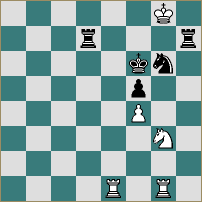
Win
Al-Adli,
ninth century
Faced with various black threats, White pulls off a tremendous swindle.
1 Nh5+! Rxh5
2 Rxg6+! Kxg6
A combination of which any modern club player would be proud. It could be presented as a study (White to play and win) or a problem (mate in three).
But hang on a second, didn't chess only reach its modern form in the fifteenth century? How can this position be genuine? In fact, the old form of chess, Shatranj, did not have queens or bishops as we know them today, but the above position contains only rooks, knights, kings and pawns - all of which moved the same way over a thousand years ago as they will tomorrow.
H. J. R. Murray in his History of Chess (1913) looked at over 500 positions that cropped up in Arabic and Persian manuscripts dating back as far as the twelfth century. Few positions showed any economy of force; many involved king hunts. Often, for dramatic and game-like significance, Black threatened mate in one, as in the above problem. There were many fine sacrifices and elegant mates.
Study composition did not reach such heights again until the nineteenth century. Kling and Horwitz established the term 'study' in their 1851 book which contained about 200 endgames. Prior to that most endgame positions found in chess books were only for didactic purposes. By 1890 Alexei Troitsky (1866-1942) and Henri Rinck (1870-1952) - considered the fathers of the modern endgame study - were already active.
The famous Saavedra position dates from 1895. Saavedra did not in fact create the position; he simply discovered the paradoxical underpromotion 6 c8R, contradicting published analysis 'proving' that the position was drawn. For that one beautiful move, his name will probably be more famous than any other grandmaster of the present era who fails to reach over 2700 standard! The study is, of course, a great one. Rich play out of a simple-looking position, a paradoxical twist at the end and an elegant flow to the logic of the solution. All from just four pieces -marvellous economy.
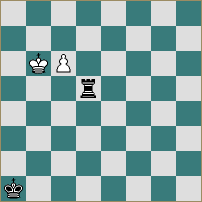
Win
F. Saavedra (Barbier),
Glasgow Weekly Citizen, 1895
1 c7 Rd6+
There is no other way to stop the pawn promoting. If, now, 2 Kc5? then 2...Rd1! 3 c8Q Rc1+ wins the queen. 2 Kb7 Rd7 is only a draw.
2 Kb5 Rd5+
3 Kb4 Rd4+
4 Kb3 Rd3+
A minor dual here in that White could have played 4 Kc3 Rd1 5 Kc2 Rd4!, transposing.
5 Kc2! Rd4!
No longer able to go `behind' the king on the c-file, Black finds a surprise defence. 6 c8Q? Rc4+ 7 Qxc4 is drawn by stalemate! Saavedra found that White could still win:
6 c8R!!
Threatens mate by 7 Ra8+ Ra4 8 Rxa4.
6 ... Ra4
7 Kb3
Threatens both the rook and the king (8 Rc1 mate). There is no defence.
This century has seen prolific activity, especially amongst Soviet composers. Many themes have been exploited almost exhaustively. There now exist vast collections of high class studies, a testimony to the enormous amount of work that has been put in by some of the great composers. You will see some of them later in the book, but here I want to present you with a personal favourite illustrating the theme of `Domination', a term coined by its composer, Henri Rinck.
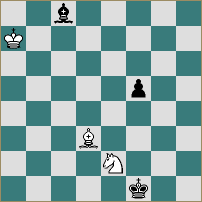
Win
H.Rinck,
Las Noticias, 1926
1 Kb8! Bd7
The only square. After 1...Be6, 2 Nf4+ wins.
2 Kc7 Be8
If 2...Ba4 3 Nc3+. The bishop and knight `battery' against the black king control all the black bishops` escape squares.
3 Kd8 Bf7
If 3...Ba4 4 Nc3+ or 3...Bg6(h5) 4 Nf4+.
4 Ke7 Bg8
The hunt continues. Incredibly all the squares are controlled, e.g. 4...Ba2 5 Nc3+ or 4...Bb3 5 Nc1+.
5 Kf8 Bh7
6 Kg7
If you tried to compose a position where the white king chases a bishop to its doom (as in the above position) you would expect a board full of pieces. Rinck controls the play with just four more pieces (including the black king). Rich content with astounding economy - the bishop is dominated over more than half the light squares on the board. To my mind this is a simply fabulous achievement.
Unusually the above endgame has no introductory sequence (sometimes known as 'foreplay'!). It just starts in the middle of the essential action (a floating domination across the board). More often composers try to hide the main idea in order to make it harder to see, and to increase the element of surprise, but this study is exceptional, and is almost perfect presented as it stands. A natural gem!
The history of the game (and its famous players) is well known. It is interesting that the development of positional theory - the theory of Steinitz and Lasker; the hypermoderns; the dynamic Russian school - has gone hand in hand with the mushrooming of study art. Figures such as Richard Réti (1889-1929) have been significant in both.
Moving, finally, onto the problem, again the major advances on what had been seen a thousand years earlier by the Muslim world came in the nineteenth century. One man, in particular, stands out: Sam Loyd (1841-1911). His problems were not only entertaining, original and elegant but also way ahead of their time in terms of thematic content. The following problem (known as the 'organ pipes') is a favourite of leading German grandmaster Gerald Hertneck. Several beginners to whom I have shown the position also expressed their admiration for it, showing just how accessible Loyd's problems can be.
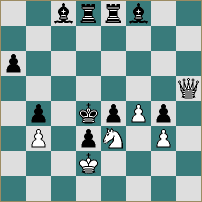
Mate in two
Sam Loyd,
Boston Gazette, 1859
The solution 1 Qa5! sets up a striking zugzwang. The black pieces cannot help but get in each other's way: 1...Bd7 2 Qd5#; 1...Be6 2 Qe5#; 1...Re7 2 Qxb4#; 1...Rd7 2 Nf5#; and 1...Bc5 2 Qa1# being sample variations. The reader should go through every legal black move just to prove it really is mate in two. The `organ pipes' - the formation from c8 to f8 - have since become an established idea seen in many more problems.
Going back to the practical value of solving problems, seeing surprising zugzwangs as in the above position can greatly help a player broaden his perspective. Weaker players tend only to see the board from their side, whereas stronger players are able to step inside the opponent’s shoes from time to time and take both sides' plans into consideration. Karpov, for example, often reaches positions where all his opponent's moves have drawbacks. It is not (humanly) possible to solve the Loyd problem without looking at both sides' possibilities.
This century has seen a great deal of activity in problem composition. Many ideas and themes have been investigated almost to exhaustion. Some people claim it is now impossible to create a genuinely original mate in two. Others have resorted to 'Fairy chess' to find new pastures. Towards the end of the book we will look at some unorthodox types of problem, but we will restrict ourselves to positions with regular chess pieces.
In the orthodox mate in three, Lev Loshinsky (1913-1976) is considered one of the greatest exponents. Some of his problems are extremely complex and sophisticated, yet still crisp and clear. In his book Solving in Style John Nunn described the following problem as 'perfect in every way'. To really understand such a problem takes time (at least half an hour probably), but it is well worth the investment. Except for its unusual quality it is a typical modern mate in three.
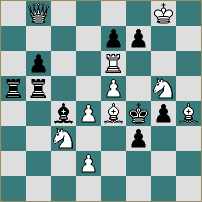
Mate in three
L.Loshinsky,
First Prize `64' 1974
Sooner or later practical players will have to face up to complicated problems with a board full of pieces. Forget your prejudices for just a few minutes and enjoy unravelling the mechanism of this problem - you will begin to see why it is necessary to have all those pieces to achieve the desired effect. The only way to force mate in three is as follows:
1 Rg6!
A surprising key, exposing the white king to various checks by moves of the f7 pawn (...fxg6; ...f6; ...f5). In fact, in view of the threat 2 Nh3+ gxh3 3 Bg3#, Black must move the f-pawn (1...Bf1 fails to 2 Ne6+ fxe6 3 Qf8 mate). There are now three variations all exploiting the intersection in the lines of action of the black pieces on the square d5. Bear in mind that the bishop on c4 prevents Ne6 mate and the rook prevents e6 mate.
a) 1...f5+ 2 Bd5! with 2...Bxd5+ 3 e6# or 2...Rxd5 3 Ne6# to follow.
b) 1...f6+ 2 d5! Rxd5 (2...Bxd5+ 3 e6#) 3 Ne6#.
c) 1...fxg6+ 2 Nd5+! Bxd5+ (2...Rxd5 3 Qf8#) 3 e6#.
Note that 2 d5? would fail to 2...g3!.
So for each of the three different moves by the black f-pawn, a different white unit plays into d5. Apart from the paradoxical element, the beauty of this problem lies in the depth and structure of the thinking needed to solve it. The solution displays great unity as well as a sort of `conceptual geometry'.
Finally, to conclude this brief survey, I want to show another of my personal favourites. It is a mate in six from early in this century. Surprisingly it is not as well known as its merits deserve.
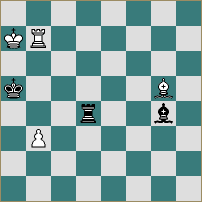
Mate in six
T.Nissl,
Akademische Monatshefte für Schach, 1910
The black king has no escape, but how does the white bishop get at it?
1 Bh4!
Threatens 2 Be1+; the black rook stops this while keeping an eye on the d8 square.
1 ... Rd1
2 Bg3! Rc1
Necessary to stop both Bc7 and Be1.
3 Bf4! Rc2
And now the bishop returns to its starting square. Such a trip is known by the German term `Rundlauf'.
4 Bg5
The rook cannot cope any longer. It is not possible to prevent both 5 Bd2 and 5 Bd8 simultaneously, so White mates in two more moves e.g. 4...Rc8 5 Bd2+ Rc3 6 Bxc3#.
Why is this problem special? If you imagine, starting from an empty board, trying to compose a position where the white bishop has to do a 'Rundlauf' (Bg5-h4-g3-f4-g5) you would expect the problem to need many more pieces. Here it is achieved in a miniature with game-like material (it is a rook and opposite coloured bishop ending with White a single pawn up). The interplay between the white bishop and the black rook is entertaining, the solution is very elegant and the setting is perfect. An underrated masterpiece.
Extract from Secrets of Spectacular Chess (J.Levitt,128 pages,Batsford,1997,£12.99 ISBN 0 7134 8049 1)
Back
Top of this page
Main page





